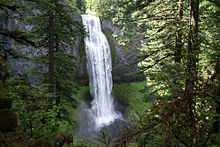Salt Creek Falls
| Salt Creek Falls | |
|---|---|
 |
|
| Location | Lane County, Oregon |
| Coordinates | 43°36′42″N 122°07′43″W / 43.61179°N 122.12861°WCoordinates: 43°36′42″N 122°07′43″W / 43.61179°N 122.12861°W |
| Type | Cascade, Plunge |
| Elevation | 3,902 ft (1,189 m) |
| Total height | 286 ft (87 m) |
| Number of drops | 1 |
| Average width | 40 ft (12 m) |
| Watercourse | Salt Creek |
| Average flow rate |
6,684 cu ft/s (189.3 m3/s) |
Salt Creek Falls is a cascade and plunge waterfall on Salt Creek, a tributary of the Middle Fork Willamette River, that plunges into a gaping canyon near Willamette Pass in the Willamette National Forest, near Oakridge, Oregon. The waterfall is notable for its main drop of 286 feet (87 m) which makes it the third highest plunge waterfall in Oregon after Multnomah Falls and Watson Falls the second highest, which was re-measured in 2009 and found to be 293 feet rather than an earlier measurement of 272 feet passing Salt Creek Falls. The pool at the bottom of the waterfall is 20 metres (66 ft) deep.
The Salt Creek Falls drops about 286 feet (87 m), which varies little in height because of the even level of the giant boulders at its crest. The waterfall has a couple of noticeable breaks by protruding rocks that interrupt the horizontal fall of the water. The average annual volume of water approaching the falls is 250 cubic feet per second (7.1 m3/s). At its crest, the waterfall sits at 3,902 ft (1,189 m) above sea level. Since the flow is a direct function of the Salt Creek water volume, it typically peaks when the mountain snow melts in the late spring or early summer. No water diversion facility exists within the falls or anywhere along Salt Creek.
Salt Creek Falls was formed when glaciers receded during the last ice age, and water from newly formed lakes upstream carved a valley through the forest. The main glacier on the Salt Creek valley seemed to have deepened the canyon at a greater rate than the tributaries, leaving the side valleys towering high above the floor of the river. Lava flows then filled in a portion of this valley, creating narrow canyon walls composed of columnar basalt that are now seen surrounding the falls.
The first reporting of an eyewitness description of Salt Creek Falls is attributed to Frank S. Warner—a resident since birth of Lane County and settler of the Middle Fork Willamette River valley—and a Warm Springs Agency Native American of Molala ancestry named Charles Tufti, who reported the discovery in March 1887. The waterfall gets its name from its parent stream, Salt Creek, a name that comes from a series of springs downstream with high salt content that are often used as mineral licks by wildlife.
...
Wikipedia
